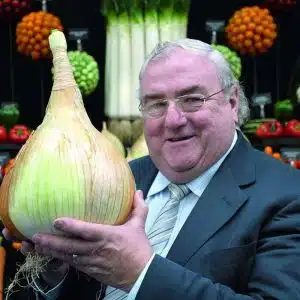Home - Growing Long Carrots

Medwyn Williams
Hello. I'm Medwyn Williams – eleven times Gold medal winner at the Chelsea Flower Show, Past Chairman of the Royal Horticultural Society Fruit Vegetable and Herb Committee and President of the National Vegetable Society.
Growing Long Carrots
My first lot of long carrots were a bit of a disaster when I sowed them in 6 inch diameter pipes for Chelsea. From the 30 pipes I had sown I have 16 left which makes it a bit of a tight squeeze for my usual way of staging them. The main reason for the failure was the fact that when they were young, they collapsed and I’m positive this was through keeping the compost too wet. By now you would think that I wouldn’t do stupid things like that! It does prove really that carrots, like most plants, are at their most vulnerable when they are at the young seedling stage and still need a little bit of TLC.
It’s just the right time now to sow Long carrots to be ready for the mid August and onwards shows and I certainly won’t let the same thing happen again. The root crops do take a lot of attention and a fair bit of physical work initially, after they have settled in though and growing away, there is very little work that needs doing to them, differently to leeks and celery that constantly require collaring etc. We are staging two large displays this year in addition to Chelsea so I will have two sowings, one now for the Dundee show which is on the first weekend in September and the other sowing will be a week later for the Malvern show on the last weekend in September.
This sowing will be done at home in plastic drums that are filled with concreting sand. This sand is rougher than your usual bricklaying or plastering sand and has helped produce some excellent specimens over the years. The drums are all in my polytunnel and lined up along the back wall and sitting on a trench of sand that I formed from what was previously my raised leek and onion beds. If you are just interested in growing for you local show you certainly don’t need a polytunnel as they will grow well outdoors.
In fact you don’t have to use drums, pipes or raised beds, simply rotavate the soil over as deep as you can, rake it level and bore conical holes in the soil with a steel bar as deep as you can, 3 inches across the top and about 9 inches apart. Fill the holes with mixture below, sow four or five seed in each station making an indentation with your finger, just as you would in the drums, to the depth of your first finger joint and cover over with the same compost as you filled the holes.You should be able to pull some good long specimens, however the only problem with this method is the lack of colour down the length of the carrot. The temperature of the soil two to three feet down can be quite cool and the best colour with carrots is when the growing medium is warm, hence the reason we grow them above ground. The other problem is that they could be quite large across the top and as the roots permeate through the bore hole mixture and into the surrounding soil, they will probably be rough as well getting far too much nutrients. In my plastic drums I will core out four holes to a depth of four feet and finish them off with a bar as deep as it will go, usually 5 feet plus. The mixtures over the years have varied immensely and this time I’m trying out the mixture that Ian Simpson uses successfully for his short carrots which is as follows –
4 gallon bucket of sieved Peat, 1 gallon of Silver sand, 1 gallon of Fine grade Vermiculite and 1 gallon of sieved top soil. To this mixture he adds 2 ounces of Calcified Seaweed, 2 ounces of garden lime, 1 ounce of Superphosphate and 1 ounce of Sulphate of potash. In addition to Ian’s mix I will also add 2 litres of Nutrimate, 10ml per litre, sprayed into the mixture as it is turning over in the concrete mixer.
Let me say at once that there is no magic mixture that will give you perfect carrots, you just need to fine tune a mixture to suit your own environment. A few years ago I asked some growers to give me their long carrot mixes and from the five asked, each mix was different, yet they all grow and stage superb carrots.
